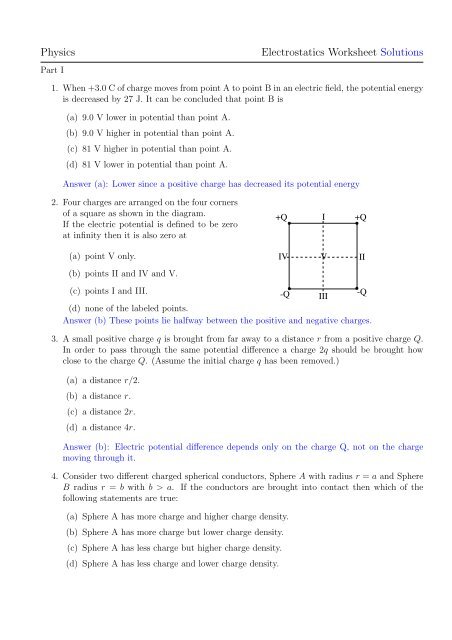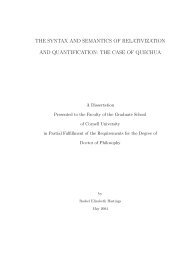Physics Electrostatics Worksheet Solutions - Academic Program ...
Physics Electrostatics Worksheet Solutions - Academic Program ...
Physics Electrostatics Worksheet Solutions - Academic Program ...
You also want an ePaper? Increase the reach of your titles
YUMPU automatically turns print PDFs into web optimized ePapers that Google loves.
<strong>Physics</strong> <strong>Electrostatics</strong> <strong>Worksheet</strong> <strong>Solutions</strong><br />
Part I<br />
1. When +3.0 C of charge moves from point A to point B in an electric field, the potential energy<br />
is decreased by 27 J. It can be concluded that point B is<br />
(a) 9.0 V lower in potential than point A.<br />
(b) 9.0 V higher in potential than point A.<br />
(c) 81 V higher in potential than point A.<br />
(d) 81 V lower in potential than point A.<br />
Answer (a): Lower since a positive charge has decreased its potential energy<br />
2. Four charges are arranged on the four corners<br />
of a square as shown in the diagram.<br />
If the electric potential is defined to be zero<br />
at infinity then it is also zero at<br />
(a) point V only.<br />
(b) points II and IV and V.<br />
+Q I +Q<br />
IV V<br />
(c) points I and III.<br />
(d) none of the labeled points.<br />
-Q III<br />
-Q<br />
Answer (b) These points lie halfway between the positive and negative charges.<br />
3. A small positive charge q is brought from far away to a distance r from a positive charge Q.<br />
In order to pass through the same potential difference a charge 2q should be brought how<br />
close to the charge Q. (Assume the initial charge q has been removed.)<br />
(a) a distance r/2.<br />
(b) a distance r.<br />
(c) a distance 2r.<br />
(d) a distance 4r.<br />
Answer (b): Electric potential difference depends only on the charge Q, not on the charge<br />
moving through it.<br />
4. Consider two different charged spherical conductors, Sphere A with radius r = a and Sphere<br />
B radius r = b with b > a. If the conductors are brought into contact then which of the<br />
following statements are true:<br />
(a) Sphere A has more charge and higher charge density.<br />
(b) Sphere A has more charge but lower charge density.<br />
(c) Sphere A has less charge but higher charge density.<br />
(d) Sphere A has less charge and lower charge density.<br />
II
Answer(c): In contact the two spheres will have the same potential, and thus the sphere with<br />
the smaller radius must have the smaller charge. (V = kQ/R ⇒ Q ∝ R). However charge<br />
density is higher for objects with lower radius of curvature.
Part II<br />
1. Illustrate how equipotential lines are drawn to represent the properties of the electric potential<br />
by drawing equipotential lines for the following charge configurations:<br />
(a) a small sphere with radius r and positive charge +q.<br />
(b) a small sphere with radius r and negative charge −q a distance 8r from a sphere of radius<br />
r with a charge of 3q.<br />
+q<br />
-q 3q<br />
(c) a small sphere with radius r and positive charge +q placed inside a larger electrically<br />
neutral conducting shell with inner radius 4r and outer radius 5r.<br />
+q
2. A gold nucleus has a radius of 3 × 10 −15 m and carries a charge of 79e?<br />
(a) What is the electric field strength at its surface?<br />
E = 1 Q<br />
4πɛ0 r2 = (9 × 109 )(79)(1.6 × 10−19 )<br />
(3 × 10−15 ) 2 = 1.26 × 10 22 N/C directed away from the<br />
nucleus<br />
(b) What is the potential at its surface?<br />
V = 1<br />
4πɛ0<br />
Q<br />
r = (9 × 109 )(79)(1.6 × 10−19 )<br />
(3 × 10−15 )<br />
= 3.79 × 10 7 Volts<br />
(c) How much energy in electron volts would be required to bring a proton from a large<br />
distance up to the surface of the gold nucleus.<br />
∆u = q∆V = (1.6 × 10 −19 )(3.79 × 10 7 ) = 6.60 × 10 −12 J= 37.9 MeV.<br />
(d) What would the initial velocity of the proton need to be in order to come this close to<br />
the gold nucleus? (Assume the gold nucleus does not recoil.)<br />
∆KE = −∆u ⇒ 0 − 1<br />
2 mv2 = −6.60 × 10 −12 ⇒ v = 8.5 × 10 7 m/s<br />
3. A potential difference of 10,000 V exists between two parallel plates which are separated by<br />
10 cm. An electron is released from the negative plate at the same instant a proton is released<br />
from the positive plate.<br />
(a) What is the kinetic energy of each particle as they reach the opposite sides? State your<br />
answer in units of Joules and electron volts.<br />
∆KE = −∆u = −q∆V = −(−1.6×10 −19 )(10, 000) = 1.6×10 −15 J for both the electron<br />
and the proton. This is just 10 Kev.<br />
(b) With what velocity does each of the particles hit the opposite plates?<br />
By conservation of energy we set ∆KE = 1<br />
2 mv2 <br />
= qV ⇒ v = 2qV/m. For an<br />
<br />
electron this gives v = 2(1.6 × 10−15 )/(9.11 × 10−31 ) = 5.93 × 107 m/s and for the<br />
<br />
proton this is v = 2(1.6 × 10−15 )/(1.67 × 10−27 ) = 1.38 × 106 m/s.<br />
(c) What is the electric field strength between the plates?<br />
E = V/d = 10, 000/0.1 = 100, 000 V/m (or Joules/Coulomb).<br />
(d) What is the acceleration of each particle?<br />
a = Fnet/m = qE/m assuming gravity is negligible compared with the electric force (it<br />
is!) so for the electron ae = (−1.6 × 10 −19 )(100, 000)/(9.11 × 10 −31 ) = −1.75 × 10 16 m/s 2<br />
and for the proton ap = (1.6 × 10 −19 )(100, 000)/(1.67 × 10 −27 ) = 9.58 × 10 12 m/s 2

















